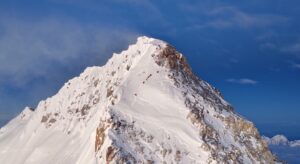Photos released on social media this week show how much climate change and pollution have affected the Rongbuk Glacier on Everest’s north side.


The vanishing. Debris on glaciers absorbs solar heat and exacerbates the effect of climate change.
The Rongbuk Glacier is located in the Himalaya of southern Tibet. Two large tributary glaciers, the East Rongbuk Glacier and the West Rongbuk Glacier, flow into the main Rongbuk Glacier, which forms the Rongbuk Valley north of Mount Everest.
Why is this glacier so important? The Rongbuk Glacier is a primary source of water for major Asian rivers such as the Indus and Yangtze, so its seasonal melt is essential to millions of people in India and China.
According to one Greenpeace study, the intense smog from nearby countries has been the main cause of the shrinkage. As the particles of soot, dirt, and smoke settle on the surface of the glaciers, they absorb the heat of the sun and promote rapid melting. Researcher Orville Schell describes the glaciers as “kind of on the run”. Can anyone blame them?
Villages in the mountains and further downstream have suffered crop failure and water shortage. Residents must travel longer distances to get access to the stuff of life.

The effects of climate change. Photo: David Breashears
This glacier is also important to the mountaineering community. The famous British Reconnaissance Expedition of 1921 first explored the Rongbuk Valley and its glacier. One of its members, Oliver Wheeler, discovered that the East Rongbuk Valley provided a direct route to the higher reaches of Everest via the North Col.

1921 vs 2009. Photo: David Breashears/Royal Geographical Society
Since 1980, the Middle Rongbuk Glacier has lost over 90 metres in depth and retreated two kilometres. In 2007, American mountaineer David Breashears compared the glacier in a 1921 photograph to what he saw before him. The great amounts of ice were gone, replaced by the mountain’s rocky shell. Since discovering the glacier’s worrisome deterioration, he has spearheaded a campaign to alert the world about the crisis.
Is it possible that Everest’s glaciers will disappear within our lifetime?






